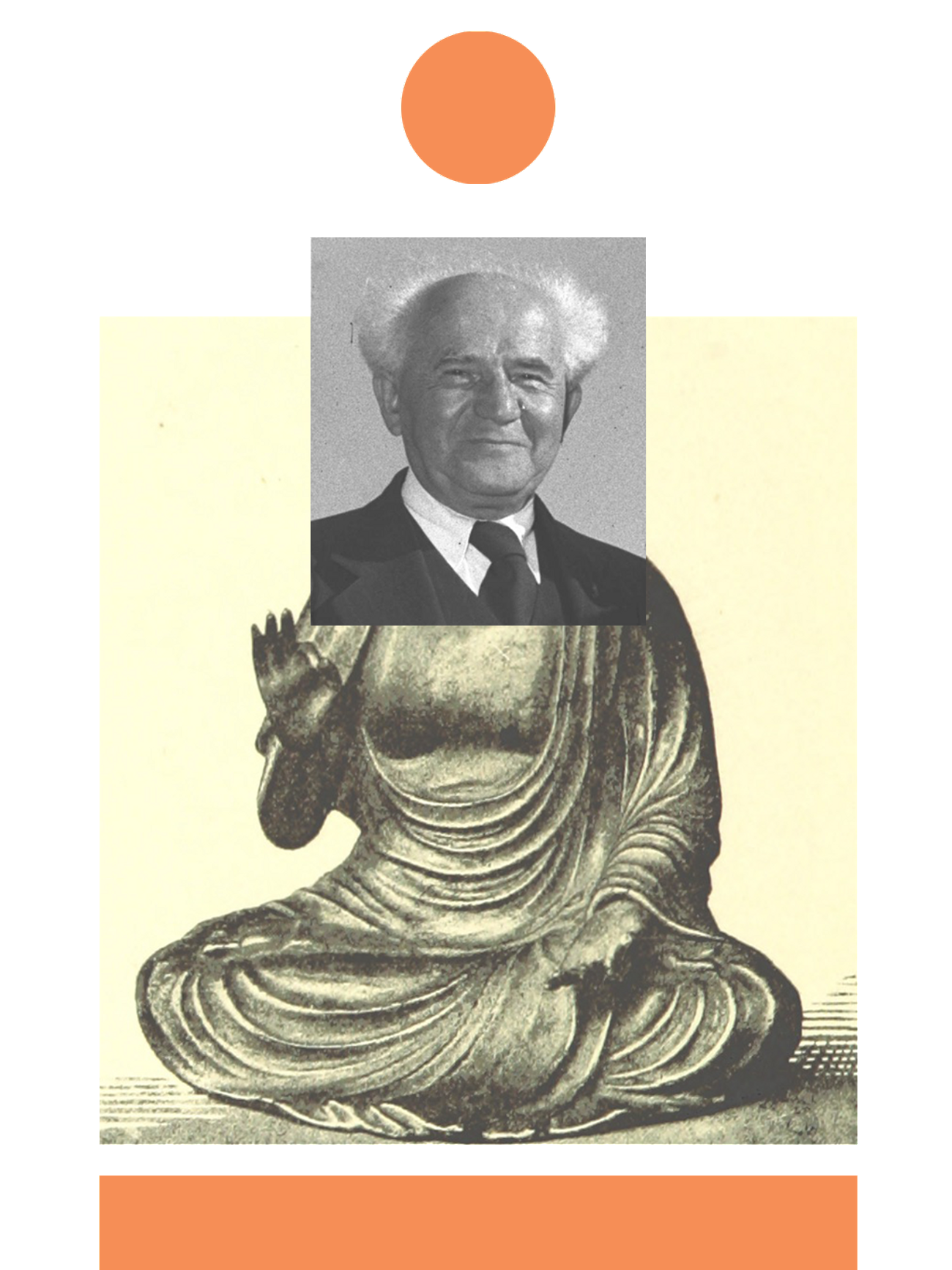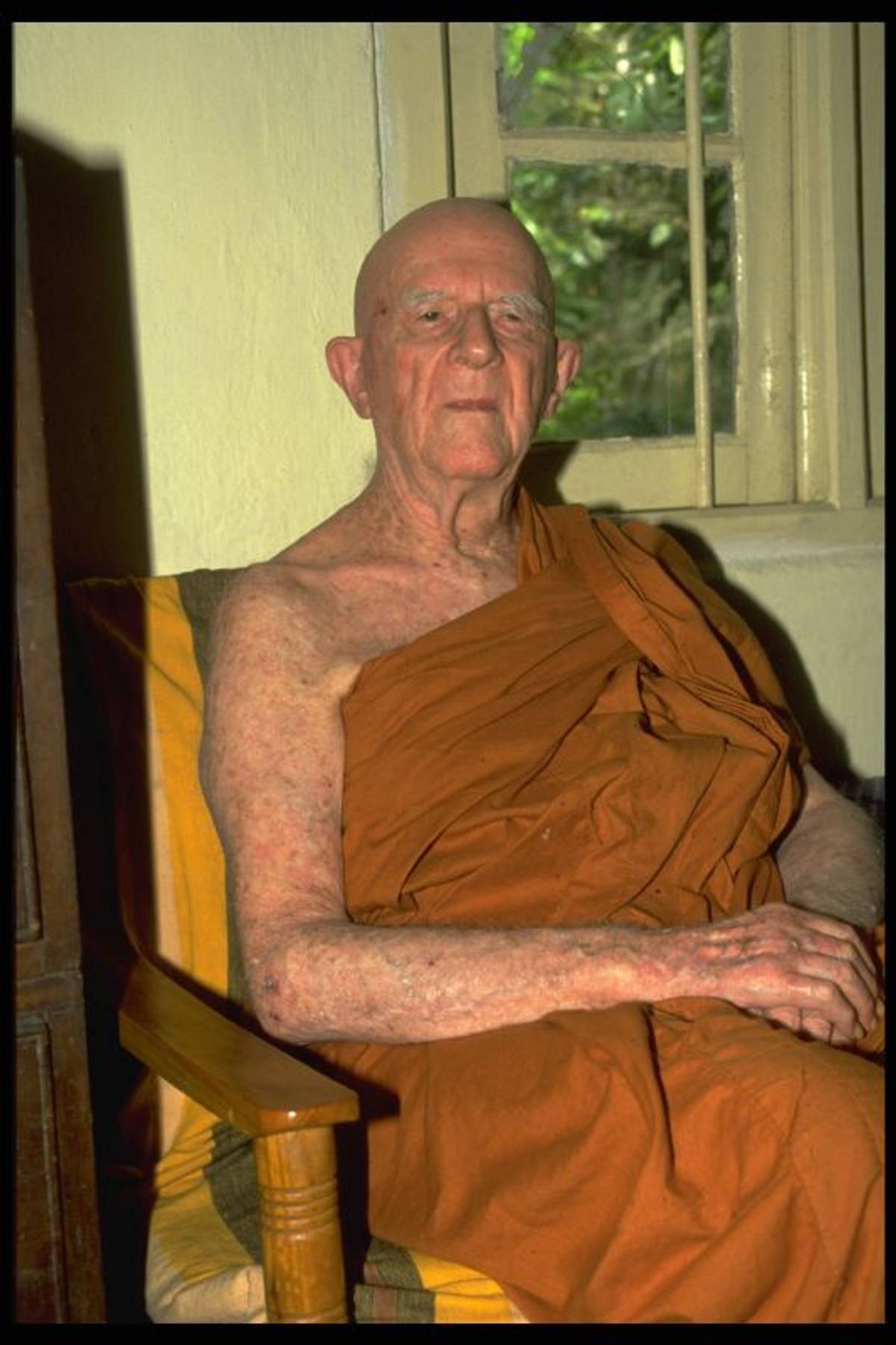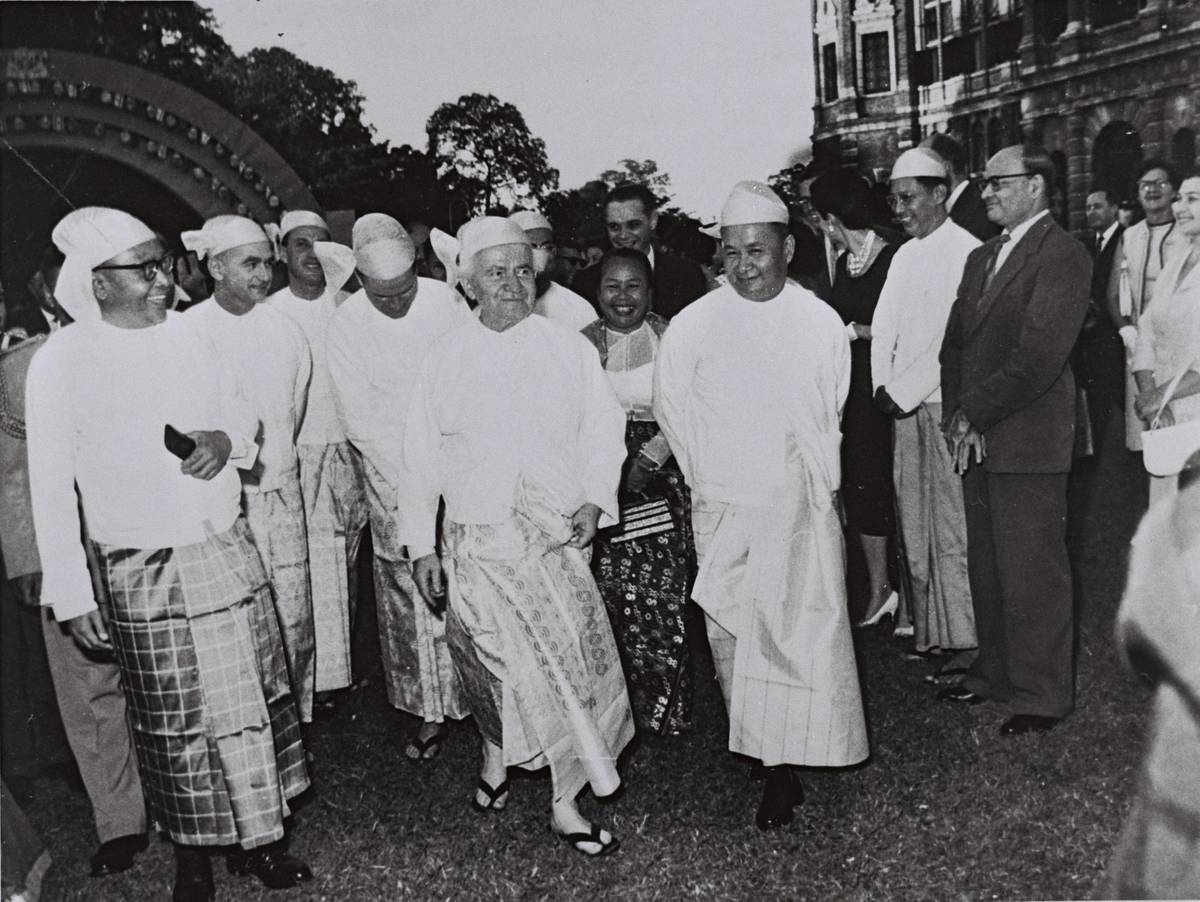The Dharma of David Ben-Gurion
Two European Jewish refugees helped remake the landscape of the possible through their friendship: One was the first prime minister of Israel, and the other was a Buddhist monk




Among the many intriguing global alliances of the late 20th century, the one between Israel and India has been one of the more compelling. Both states gained their independence at about the same time (1948 and 1947, respectively). Both understand themselves to be fragile and yet vibrant democracies surrounded by hostile Muslim states. In addition to the political similarities, the mutual cultural fascination has lasted decades. In Israel, ashrams, meditation centers, and teachers of both Hindu and Buddhist traditions are a common part of the cultural scene and India remains a top travel spot for young Israeli soldiers spending some down time after army service. Dissertations, monographs, and articles abound about the way in which Asian religions have taken root in Israeli secular life. Orthodox rabbis even feel the need to comment upon it as a phenomenon that they feel threatens the Jewish identity of Israelis who choose to follow those paths. Israel is a model for some on the Hindu right, who see it as a state where a dominant religion can aspire to remain dominant without compromising democratic values. As scholar of India Laurie Patton and I pointed out in the early 2000s, and as many scholars have remarked upon since, the multiple layers of the Israel-India relationship are dynamic and evolving.
It would be tempting to think that Israeli engagement with Asian religious traditions started during the 1960s, and it certainly had a strong cultural push during that decade. But its roots are decades earlier, in the 1930s, when a young Zionist left Germany to study Buddhism in what was then Ceylon, and then, 20 years later, developed a correspondence with the Israeli prime minister, David Ben-Gurion, who was born 134 years ago today. How did this unlikely relationship between a serving prime minister and a reclusive scholar of Eastern religions come about?
The relationship between the two men began in a diplomatic context. In 1955 the prime minister of Burma, U Nu, came to Israel on a state visit. He was the first head of state to visit Israel and the Israeli government was eager to cement ties with emerging Asian nations. Aware that normal diplomatic relations with Arab and Muslim nations were not within the realm of the possible, Ben-Gurion and his advisors had been working on a “strategy of the periphery,” which sought to cultivate emerging states in Africa and Asia. As Israeli scholar Avi Shilon noted in his Hebrew-language essay on Ben-Gurion, India, and Buddhism, “Ben Gurion hoped that with the help of India he could establish diplomatic and economic ties that would free Israel from the isolation it was subject to because of the hostility between itself and its neighbors.”
During his 1955 visit to Israel U Nu and Ben-Gurion formed a friendship that would endure for the rest of their lives. Ben-Gurion, interested in Buddhism, asked U Nu to put him in touch with Buddhist scholars in Asia. And, two years later, in 1956, Ben-Gurion received a letter from Nyanaponika Thera of Ceylon.
One can only imagine the Israeli prime minister’s surprise when he read the letter’s opening lines:
May I first introduce myself as a Buddhist monk of a Jewish origin, born in Germany. My late parents were Eastern Jews, born in Galizia (Austria). I am 55 years of age, and entered the Buddhist Monastic Order (Sangha) in Ceylon twenty years ago under the well-known German monk-scholar Nyanatiloka Mahathera. I am now a citizen of Ceylon.
A few days ago, a Government official told me that his department had received a request of yours for Buddhist literature. ... I request that you kindly inform me of your wishes, and I shall do my best to obtain these books for you through my lay friends here (we Buddhist monks do not possess or handle money).

In introducing himself as a simple monk, Nyanaponika Thera was being more than modest. Nyanaponika Thera had by the mid-1950s reached the intellectual and clerical leadership of Theravada Buddhism. Along with his teacher Nyanatiloka Thera (Anton Gueth), a German Catholic convert to Buddhism of an earlier generation, Nyanaponika Thera was assigned the task of reediting and printing the entire Pali Canon. The two scholars completed this enormous assignment and presented their findings to the Sixth Buddhist Council, convened in what was then Burma in 1964.
Theravada tradition, literally the “School of the Elders,” is an early form of Buddhist teaching whose contemporary practitioners mostly now reside outside of India, such as in Sri Lanka, Myanmar (formerly Burma), Thailand, Cambodia, and Laos. It is organized around the scripture of the Pali Canon, said to be the sayings and doings of the Buddha written down by his followers after his death. Its focus is on individual meditation and insight, and also on a strict code of monastic life. Contemporary practitioners of vipassana, or insight meditation, place their practice in this lineage.
In his first letter to Ben-Gurion, Nyanaponika Thera alludes to Israel’s military and political situation in the aftermath of the 1956 Sinai Campaign. “I was deeply moved,” he wrote, “that even in these grave days for Eretz Israel and with your great burden of responsibility, your interest in the Buddha’s teaching has not slackened.”
Buddhist teachings, Thera explained to Ben-Gurion, would help him cope with that “great burden of responsibility” of being prime minister. “It is my firm conviction,” the monk wrote, “that, to one who understands the essence of the Dharma and tried to apply certain of its methods of mental training, it will bestow an increased inner strength and capacity to deal with the tasks of everyday life.”
When they began to write to each other about Theravada practices, Nyanaponika was 55 years old and Ben-Gurion was 70. Both men had undergone a radical transformation. In 1906, at the age of 20, Dovid Yosef Gruen of Plonsk moved to Ottoman Palestine and adopted the heroic Hebrew name Ben-Gurion. In 1936, at the age of 35, Sigmund Shlomo Feniger left Europe for Ceylon and there was ordained a Buddhist monk and given a Pali name meaning “inclined to knowledge.”
Israeli scholar Asaf Federman, who brought the Ben-Gurion–Nyanaponika Thera letters to light in 2002, saw several links between Buddhism as presented by the monk and Ben-Gurion’s idea of a secular, nonrabbinic Judaism. Both were cleansed of excessive ritual and both were based more in science than in dogma. In Buddhism, Federman noted, Ben-Gurion “saw a system very similar to his vision of Judaism, and yet different enough as to articulate the uniqueness of the modern Jewish situation.”
In their correspondence, the prime minister was eager to learn about Buddhism and the monk was eager to teach. To be sure, such curiosity was not unusual for the Israeli leader. Ben-Gurion, completely self-educated, had very wide-ranging interests. His curiosity about Buddhist teachings seems to have originated in his lifelong fascination with India. While Buddhism had dwindled as a major religious tradition in India in the late first millennium, Ben-Gurion was aware of its roots in that culture. In 1930, Ben-Gurion passed through Calcutta and the city and its people left a vivid impression on him. In the 1940s, as Ben-Gurion envisioned and worked toward the emergence of a Jewish state in Palestine, he saw India as that future state’s natural partner. Both had struggles against British rule and sought their places in the international order.
Ben-Gurion sought information about Buddhism within Israel, too. Four years before he and Nyanaponika Thera began their correspondence, Ben-Gurion asked Israeli scholars about primary sources for the study of Buddhism. He wrote to Emanuel Olsvanger, the Israeli linguist and translator who had visited India in 1936 and 1942, for information about Buddhism, and in within a few years Olsvanger compiled a book of Hebrew translations from Sanskrit and Pali into Hebrew.
The correspondence lasted through challenging times in Israel’s history and in Ben-Gurion’s own life. In October 1957, a disgruntled Jewish immigrant from Iraq threw a military hand grenade into a session of the Knesset, the Israeli parliament. Tossed from the visitors gallery, the grenade exploded near the table where government officials usually sat. Five members of the government were injured; one of them, Religion Minister Moshe Haim Shapira, was injured quite seriously. Prime Minister David Ben-Gurion had wounds on his arms and legs and was hospitalized.

Among the government members injured, Ben-Gurion was said to have remained the calmest in the immediate aftermath of the attack. According to one news report Ben-Gurion “picked himself off the floor and walked into the Knesset lobby.”
Among the many letter of support that Ben-Gurion received while recuperating in the hospital was a personal note from Nyanaponika Thera. Ben-Gurion told his secretary to quickly acknowledge Nyanaponika Thera’s letter and assure him that the prime minister was recovering, and send his thanks and warm regards.
The Israeli prime minister and the Theravadan Buddhist monk had at that point been corresponding for a little over a year. Later in their correspondence, Nyanaponika Thera suggested to Ben-Gurion that many Israelis, and not only the prime minister, could benefit from Buddhist practice. Thera, in a letter in which he refers to himself as a Jew, wrote that “Among our Jewish people that has undergone and still undergoes so much suffering and yet preserved its inner strength and creativeness, there might be some to whom the Buddha’s teaching of the Deliverance from Suffering will appeal.”
At the letter’s end Thera mentions that he was once a Zionist, but as a young man he felt that he had to choose between Zionism and Buddhism. It is striking that nowhere in this initial letter does the monk use his given Jewish name. Only later would Ben-Gurion learn that Thera’s name had been Sigmund Shlomo Feniger. One can only assume that with his vows to become a monk in the Theravadin Buddhist tradition Feniger gave up the use of his European Jewish name and never returned to it.
Though a confirmed Buddhist, Thera did not deny the significance and value of his Jewish education, or of his knowledge of Hebrew. He was eager to find a Hebrew translator and Israeli publisher for his teacher’s book, The Word of the Buddha. He noted that he would have liked to translate the book himself, “But, to my great regret,” he wrote, “my own knowledge of Hebrew is limited to the biblical lessons of childhood, and a short course in modern Hebrew in adolescence when I was a member of the Zionist movement.”
While Ben-Gurion is inscribed in Jewish history as the founder of the first successful Jewish state in 2,000 years, Thera’s influence was of a different kind—though in some circles, equally pervasive. In 1954, two years before he corresponded with Ben-Gurion, Nyanaponika Thera wrote The Heart of Buddhist Meditation, a guide to the meditation techniques of the Therevada tradition. The book was to become a classic, circulating from the 1970s onward amongst people interested in learning more about Buddhist meditation.
Thera’s book deeply influenced many future Buddhist teachers in the West, including Jack Kornfield, Sylvia Boorstein, and Jon Kabat-Zinn. Kabat-Zinn described it as “the book that introduced vipassana and mindfulness to the West.” Yet, in the early 1970s, when these future Jewish Buddhist leaders were reading and discussing this book, Nyanaponika Thera’s former identity as Shlomo Feniger wasn’t a topic of discussion. Thera’s Jewish origins were acknowledged only four decades later in Sylvia Boorstein’s 2014 foreword to The Heart of Buddhist Meditation. Boorstein wrote that when first reading Nyanaponika’s book, she felt “a warmth and friendliness in his tone that makes me feel as if he is talking to me. The fact that I feel him as family is multi-layered, I’m sure. ... Like Nyanaponika, my grandfather, with whom I was very close all of his ninety-eight-year life, was a Jew born in German-speaking Europe.”
So who was he? Shlomo Feniger was born in Frankfurt, Germany, in 1901. He attended state schools, where he excelled at the study of Latin, Greek, and French. His parents arranged for a Hebrew tutor, a subject the young student took a strong interest in. He moved to Berlin in 1922 and there joined a group of German students interested in the study and practice of Buddhism. Their interest was generated by books, but only partially satisfied by books; in Germany, they found no teacher they considered authentic. But they knew of Anton Gueth, a German living in Ceylon who had founded a retreat center for Westerners willing to travel to his Island Hermitage and undergo intensive meditation training and language instruction.
With the Nazi rise to power and the implementation of the Nuremberg Laws, Feniger was eager to leave Germany and find refuge in British-ruled Ceylon. Within a year of arriving at the hermitage he was ordained as a novice monk and given the name Nyanaponika, “inclined to knowledge.” In 1938, through the influence of his teacher Gueth-Nyanatiloka, Feniger was able to arrange a British visa for his mother, who gained residency in Ceylon. Within a few years she herself converted to Buddhism. She lived in Ceylon until her death in 1956.
An adept writer in German, English, and Sinhalese (the language of Sri Lanka) Feniger-Nyanaponika rose to the directorship of the Buddhist Publication Society, which was devoted to spreading the teachings in the English-speaking world. He led the society for 30 years and retired from it in the mid-1980s.
The correspondence between Ben-Gurion and Nyanaponika Thera extended over a period of six years. When Ben-Gurion learned that Nyanaponika Thera’s brother Itzik Feniger was living in Israel he tried to arrange for Nyanaponika Thera to visit Israel, but this plan never came to fruition. But the epistolary friendship between the two former European Jewish seekers influenced Ben-Gurion deeply, as did his more direct and personal friendship with Burmese Prime Minister U Nu, a devout Buddhist practitioner.
Ben-Gurion’s curiosity about Buddhism, like Feniger’s, began with books and then extended into the real world. Six years after the Burmese prime minister’s visit to Israel and four years into the correspondence with the Thera, Ben-Gurion made a state visit to Burma, where he spent 16 days. On this visit he was accompanied by high-ranking Israeli civilian and military officials. The first week of the visit was devoted to political and military talks; the second to a Buddhist retreat in which only Ben-Gurion and local Buddhist teachers participated.
Ben-Gurion’s interest in Buddhism persisted until his death in December of 1973. In the decades since his death Israeli study and practice of Buddhism has flourished. Ben-Gurion’s wish, expressed in the mid-1950s, that Israel’s universities take up the study of Asian languages and cultures, found full expression in the 1980s and ’90s. And the large numbers of young Israeli travelers to India brought more awareness of Asian religions in general, and of Buddhism in particular, to Israel.
Nyanaponika continued to write and teach until his death at 93 in 1994. In his early 30s, he had escaped Nazi Germany and an intolerant Europe and remade himself as a Buddhist. Through his correspondence with Ben-Gurion Feniger-Nyanaponika influenced Israeli culture and helped shape some part of the inner life of the Jewish state. Each year from 1968 to 1981 he visited Switzerland and taught a two-month-long seminar on Pali texts and Buddhist meditation, bringing Buddhist teachings back to Europe. In a way, his teaching had come full circle.
Shalom Goldman is Professor of Religion at Middlebury College. His most recent book is Starstruck in the Promised Land: How the Arts Shaped American Passions about Israel.